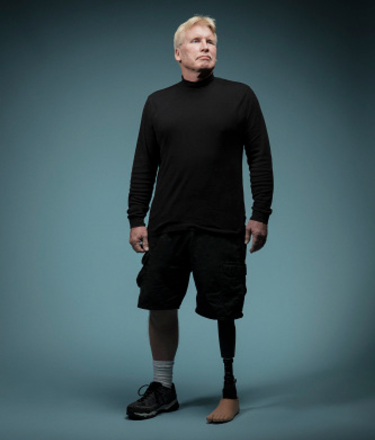Discoveries
Innovation 9: (Out on) a Better Limb
Aug 15, 2018 Cassie Tomlin
The next step in prosthetic technology revolutionizes mobility for one amputee—and may help countless others.

Thanks to an innovative new technique that increases stability and range of motion in prosthetics, Chris Rowles enjoys renewed confidence and mobility. Photo: Max Gerber
The Problem
After seven knee replacements, 28 operations, and 11 aggressive infections, Chris Rowles finally lost his left leg to amputation. The former police officer, an energetic fisherman and beachgoer, is one of nearly 2 million people in the United States living with limb loss—many of whom seek artificial appendages. Following the operation to remove his lower leg, he was outfitted with a traditional socket prosthesis. His prosthetic adhered to the skin and soft tissue of his thigh through a specially shaped cup, held on by nothing more than “hope and suction,” he says.
Rowles never entirely trusted his replacement limb, which threw off his natural gait and caused him back problems. Though he lived with the apparatus for five years, it never really stuck. “There were times I would lose the suction on the socket and keep walking and my leg would be behind me,” he says. He’s not alone: Many patients avoid or abandon socket prosthetics because of pain, balance problems, or bad fit.
The Solution
Last year, at Cedars- Sinai, Rowles became the first patient in Southern California to undergo a new procedure for leg amputees called osseointegrated prosthetic limb surgery. The procedure was performed by Daniel C. Allison, MD. The technique aims to make the prosthesis an extension of the existing bone—increasing stability and range of motion. Surgeons first implant a titanium stem inside the femur (thighbone). Then, in a second surgery, a bolt is attached to the stem that extends outside of the thigh. The prosthetic lower leg slides into the bolt and, with a few twists, is locked in place, without the irritation and instability of the suction-cup prosthetic.
When he first connected his prosthetic to the bolt, Rowles was delighted to perform a simple motion that had eluded him for seven years: crossing his legs. “I know that’s a silly thing, and it’s a simple thing, but it’s something I was looking forward to,” he says. Now able to stroll on the beach with relative ease, Rowles considers the transition a complete success.
The technology is new, but early positive results suggest that more patients will soon benefit. For Rowles, his new prosthetic props him up in more ways than one. “I feel so much more confident in myself—that’s what carries me,” he says.
More Innovations to Transform Medicine in the Next Decade
- Innovation 1: The Digital Doctor
- Innovation 2: Cancer Cures in a Dish
- Innovation 3: The Mundane and the Fantastic
- Innovation 4: The Smart Hospital Room
- Innovation 5: Genetic Testing for All
- Innovation 6: Broader Diagnosis
- Innovation 7: A Very Patient Device
- Innovation 8: Pro Solutions to Antibiotics Problems
- Innovation 10: The XR Files
- From Idea to Innovation
- A Short List of Failed Innovations



